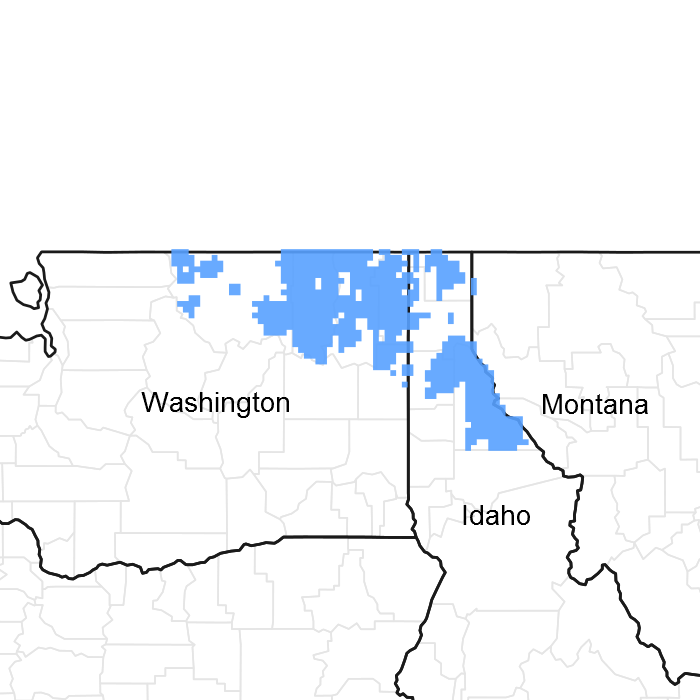
Natural Resources
Conservation Service
Ecological site F043AY517WA
Warm-Frigid, Xeric, Loamy Foothills/Mountainsides, ashy surface (Douglas-Fir/Warm Dry Shrub) Pseudotsuga menziesii / Physocarpus malvaceus - Symphoricarpos albus
Last updated: 10/14/2020
Accessed: 12/21/2025
General information
Provisional. A provisional ecological site description has undergone quality control and quality assurance review. It contains a working state and transition model and enough information to identify the ecological site.

Figure 1. Mapped extent
Areas shown in blue indicate the maximum mapped extent of this ecological site. Other ecological sites likely occur within the highlighted areas. It is also possible for this ecological site to occur outside of highlighted areas if detailed soil survey has not been completed or recently updated.
MLRA notes
Major Land Resource Area (MLRA): 043A–Northern Rocky Mountains
Description of MLRAs can be found in: United States Department of Agriculture, Natural Resources Conservation Service. 2006. Land Resource Regions and Major Land Resource Areas of the United States, the Caribbean, and the Pacific Basin. U.S. Department of Agriculture Handbook 296.
LRU notes
Most commonly found in LRU 43A02 (Western Selkirk Mountains). This LRU is composed predominantly of the slopes of foothills or mountains west of the main Selkirk Range and above the surrounding Columbia and Colville River valleys. These are primarily the Kettle and Huckleberry ranges. The LRU is in the portion of the Northern Rocky Mountains that was subjected to continental glaciation. The soils tend to be loamy andisols and inceptisols with volcanic ash surfaces. Material from metamorphic rocks, till and outwash are the dominant parent materials. Soil climate is a frigid or cryic temperature regime and xeric or udic moisture regime with average annual precipitation around 660 mm (26 inches) and an average annual air temperature around 6.2 degrees C (43 degrees F). Elevation ranges from about 645 to 1735 m (2,115 to 5,690 feet).
Also found in adjacent areas of 43A01 and 43A03. Climate parameters were obtained from PRISM and other models for the area. Landscape descriptors are derived from USGS DEM products and their derivatives.
Classification relationships
Relationship to Other Established Classifications:
United States National Vegetation Classification (2008) - A3392 Douglas fir- P. Pine / Shrub Understory Central Rocky Mt. Forest & Woodland Alliance
Washington Natural Heritage Program. Ecosystems of Washington State, A Guide to Identification, Rocchio and Crawford, 2015 - Northern Rocky Mt. Dry-Mesic Montane Mixed Conifer Forest (D. Fir – Pine)
Description of Ecoregions of the United States, USFS PN # 1391, 1995 - M333 Northern Rocky Mt. Forest-Steppe-Coniferous Forest-Alpine Meadow Province
Level III and IV Ecoregions of WA, US EPA, June 2010 - 15x Okanogan Highland Dry Forest. 15w Western Selkirk Maritime Forest. 15r Okanogan – Colville Xeric Valleys & Foothills.
This ecological site includes the following USDA Forest Service Plant Associations: PSME/PHMA, PSME/PHMA-LIBOL and PSME/SYAL (Douglas-fir Series). (Williams et. al. 1995)
Ecological site concept
This site consists of hillslopes and mountain slopes with the following characteristics: loamy soil materials; a water table (perched or apparent) more than 75 cm (30 in) below the soil surface during the April to October period; a volcanic ash mantle more than 18cm (7 inches) thick; cumulative available water capacity to 100 cm (40 inches) of more than 7.5 cm (3 inches); PSME/PHMA or PSME/SYAL habitat type.
Table 1. Dominant plant species
| Tree |
(1) Pseudotsuga menziesii var. glauca |
|---|---|
| Shrub |
(1) Physocarpus malvaceus |
| Herbaceous |
(1) Calamagrostis rubescens |
Click on box and path labels to scroll to the respective text.